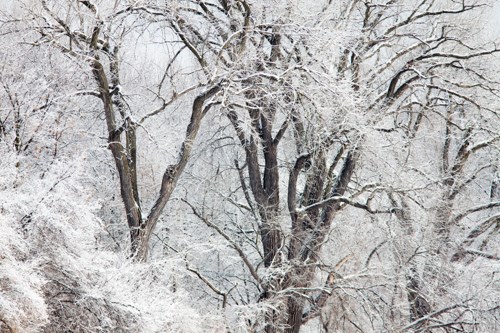
NPS/Gordon Dietzman IntroductionThis large tree may grow 60-80’ tall with a trunk up to 90” in diameter. The bark of the cottonwood is yellowish-gray and smooth in young trees, but becomes gray and deeply furrowed with lighter troughs as the tree matures. Its leaves are triangle shaped and toothed along the edge. Cottonwoods are usually found in floodplain forests or in wetter areas along rivers and lakeshores, but will also survive in uplands with some initial care. They are, however, fast-growing and short-lived ornamental trees in the suburbs and their large size and short lives may pose threats to nearby buildings. They also produce enormous quantities of cottony seeds that drift on the wind that many people find annoying. RestorationThe National Park Service is working with partner organizations, like the Mississippi Park Connection, Minnesota GreenCorps, Saint Paul Parks and Recreation, and the University of Minnesota, to determine which approaches will add younger cottonwoods to the riparian ecosystem. Over the past few decades, cottonwood trees have not been regenerating at their historic rate. This is due to a variety of possible factors, including changes in river flow, and climate change. Planting cottonwood seeds, cuttings and saplings help to determine which is the best approach for the restoration effort. The different plantings will be monitored over time and the results shared with park districts within the national park so they will be better able to restore cottonwoods to their riparian areas. The cottonwood tree is a floodplain forest foundation species, meaning that it is a species that creates stable conditions for other species. It is one of the first to grow in recently flooded areas, which has the effect of stabilizing dynamic river channels by reducing erosion and creating suitable habitat for other vegetation. As cottonwoods grow, sometimes as high as 100 feet, they shield the area around them from sunlight, enabling the establishment of trees that require shadier conditions. Over time, cottonwood trees turn sandbars into mature floodplain forest habitat that can support a large variety of species. Many birds and other land animals rely on cottonwood trees and the habitat they create. For example, they are the preferred nesting trees for bald eagles because they require large branches to support their large nests. These birds also require perches with a high vantage point so they can scan larger portions of the river for prey. Bees also rely on cottonwoods because they use the antimicrobial properties of cottonwood resin to make bees in their hive less susceptible to disease. Cottonwood trees also improve aquatic habitat. In time, cottonwood trees will provide shelter for fish. When cottonwoods grow near a river channel, the river erodes the banks around them until the tree is left on unstable footing. When it falls into the river, the branches, which previously would have been home to terrestrial birds and insects, will shelter aquatic invertebrates and fish. The branches in the river also help to improve water clarity by acting as a filter to remove soil and dirt sediment in the water. Fascinating Facts
Find ItCrosby Farm Regional Park Want to Help Us Better Understand the Park?See our iNaturalist project, "The Life of the Mississippi National River and Recreation Area" and contribute to it by downloading the iNaturalist app and uploading your sightings of this species, and others, to the project. You can also upload your sightings from your computer.
|
Last updated: March 7, 2018
